My Travels With Pope Francis in Paraguay
July 8, 2015 - NYTimes
By Jim Yardley
I am traveling with Pope Francis as he visits Ecuador, Bolivia and Paraguay. Follow along as I chronicle the trip here, and on Twitter and Instagram.

Waiting for Pope Francis in El Alto, Bolivia. Credit William Neuman
Striking Contrasts as Pope Francis Arrives in Bolivia
July 8, 2015
My colleague, William Neuman, has contributed to this notebook from El Alto, Bolivia:
Nuns in black and white habits waving yellow and green pompons. An indigenous priest in a cowboy hat playing the electric mandolin.
Indigenous women with weathered faces, bowler hats and wide skirts, chatting in the Aymara language while waiting beside the red carpet.
A stage made of adobe bricks and salt blocks festooned with quinoa stalks, under an azure sky. The massive Andes snow peaks in the distance, the ancient home of pre-Columbian gods, still called by their ancient names.
And then, in walks the pope.
There may be no moment in Pope Francis's three-nation trip to South America that provided such striking contrasts and images as his arrival here in the Bolivian city of El Alto, about 13,450 feet above sea level.
Francis appeared in white robes with a traditional woolen chuspas around his neck: a bag to carry coca leaf.
El Alto is unique on the continent: a wholly indigenous city, a city of close to a million people created by indigenous farmers and miners moving from the countryside. It has a culture and a vision deeply rooted in Andean Indian experience — a separate world from the Western vision of both the church and modern culture.
Waiting for the pope, Father Ramiro Braulio, 38, an Aymara Indian, explained how his parishioners in Achacachi, a farming village, mix ancient rituals with Catholic worship: performing rites to bless the earth before planting (with rosary in hand) or ceremonies to bring rain (while making the sign of the cross and invoking St. James, who is believed to have a connection to lightning).
Father Braulio did not think the gap was too wide for Francis, who has stressed the need to reach out to what he calls the periphery.
"When he goes to Bolivia, when he goes to Israel, to China, he goes to see and understand," Father Braulio said. "His mission is to go everywhere."
More Posts
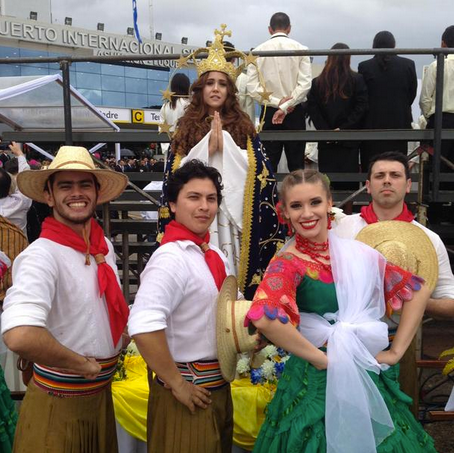
Waiting to perform for Francis at the airport in Paraguay.
Dramatic Welcome as Pope Francis Arrives in Paraguay
July 10, 2015
Pope Francis arrived in Asunción, the capital of Paraguay, on Friday afternoon, beginning the third and final leg of his Latin American tour before he returns to the Vatican on Sunday.
President Horacio Cartes greeted him on the tarmac, and the welcoming ceremony rivaled the singing soldiers in La Paz, Bolivia. A children's choir sang. Performers danced.
Francis was scheduled to meet with Mr. Cartes and other diplomats later in the evening.
Pope Francis Attacks Global Economic System
July 10, 2015
Pope Francis is finishing the second leg of his Latin American trip in Bolivia, and is now boarding the plane to go to Paraguay. Last night was the big speech of his trip. He managed to tie together both a historic apology to his fellow Latin Americans about the Roman Catholic Church's role in the abuses of the colonial era and position the church as an agent against what he called a "new colonialism."
This has landed with a bang in Latin America, but also in the rest of the world.
This speech in Bolivia will make his September trip to the United States very interesting. His attack on the global economic system could be read as a stern critique of some aspects of American capitalism.
Francis remains difficult to define. He doesn't appear to be the sort of radical leftist like President Evo Morales of Bolivia. There were some moments on this trip that seemed to catch him off guard, like when Mr. Morales gave him a cross shaped like a hammer and sickle. The pope smiled and seemed to hand it off as quickly as he could.
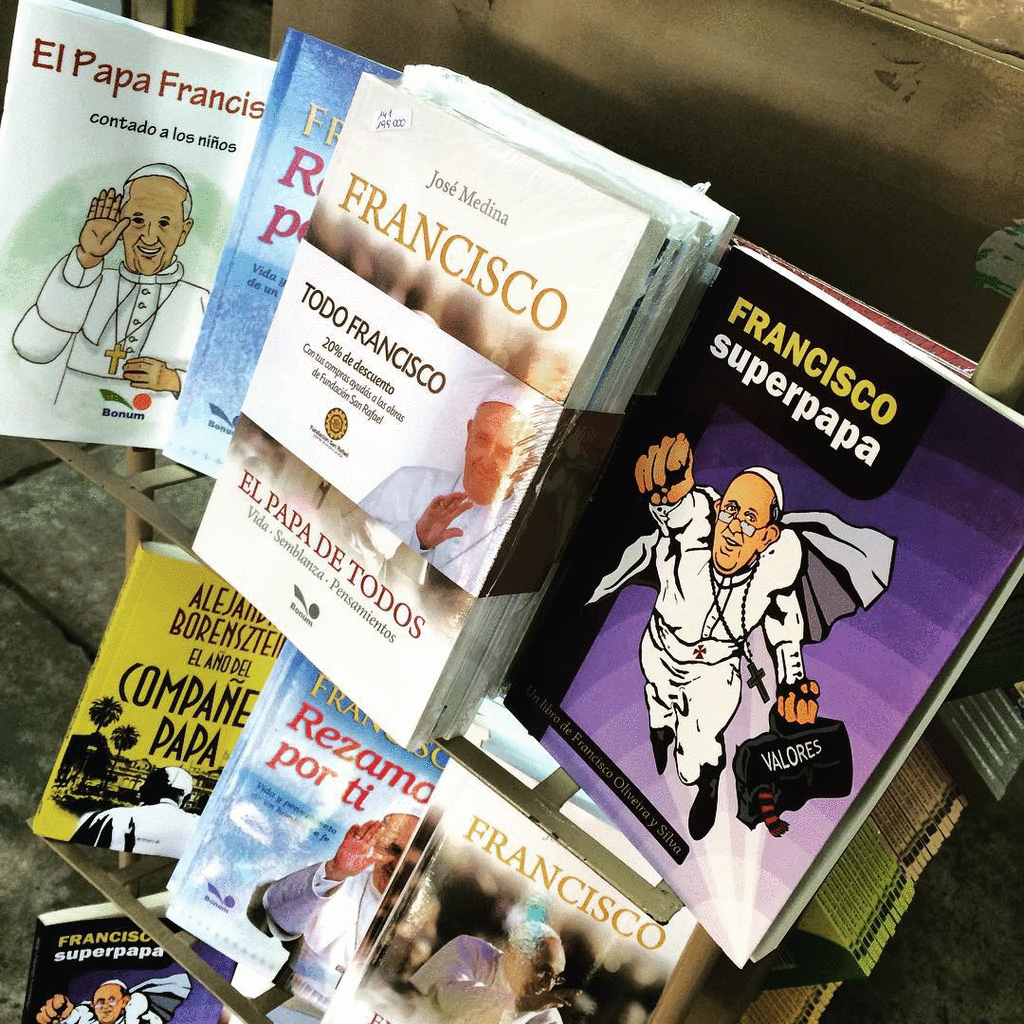
"Superpope" among the offerings at the Servilibro bookstore in one of Asunción's tree-lined plazas. Francis is set to arrive in Paraguay on Friday for the last leg of his trip through South America. Credit Simon Romero
Church in Paraguay Holds Sway on Social Issues
July 10, 2015
My colleague Simon Romero writes from Asunción, Paraguay:
In preparation for Pope Francis's arrival here Friday afternoon, the authorities had some advice for people planning to hold signs at gatherings calling for the legalization of same-sex marriage or abortion: Don't even think about it.
"We'll be before the eyes of the world, and such signs could be offensive," Elisa Ledesma, a spokeswoman for the national police, told a local radio station.
The police changed their tune after the ban was publicly denounced, explaining that they had planned to prohibit only large signs obstructing people's view. But the fact that the police felt they could declare such a measure in the first place points to some of the advantages and challenges that the Roman Catholic Church has in Paraguay, a landlocked country of about 6.7 million.
In a region where Argentina pioneered the legalization of same-sex marriage in 2010 and Uruguay legalized abortion in 2012, Paraguay remains socially conservative. Eighty-nine percent of Paraguayans are Catholic, the highest percentage of any country in Latin America, according to the Pew Research Center, and the church holds huge sway on social issues.
"Paraguay is the paradise of fundamentalists," said Rosa Posa Guinea, 50, an activist with Aireana, a lesbian-rights group here whose president declined an invitation to meet with the pope on Saturday, along with the leaders of other organizations. "The pope may be better than his predecessor, but that doesn't mean his church is prepared to support our rights."
A reminder of the church's power came this year when judicial officials barred a 10-year-old girl who was raped from terminating her pregnancy, prompting discussion about the country's strict abortion laws.
Same-sex marriage also remains illegal, and President Horacio Cartes, a tobacco magnate, likened gays to "monkeys" during his campaign. (He later apologized.)
Still, some here view Pope Francis's visit as a chance for debate. Billboards around Asunción, paid for by gay-rights groups, show images of same-sex couples embracing next to remarks the pope made in 2013 suggesting that he would not pass judgment on gay priests for their sexual orientation: "Who am I to judge?" he asked.
Pope Francis and the Coca Leaf Saga
July 10, 2015
In the end, Pope Francis didn't chew.
When he arrived in Bolivia, one of the things people were most curious about was whether he would chew on coca leaves, which are sacred to the indigenous population but face legal strictures around the world because they form the raw materials of cocaine. Many people in high altitudes of Bolivia chew the leaves as a cultural tradition, and they are a mild stimulant.
The Vatican did confirm that the pope drank a blended tea that contained some coca leaf tea on the plane coming into La Paz. When Pope John Paul II came to Bolivia in 1988, he also drank coca leaf tea.
At a welcoming ceremony, President Evo Morales of Bolivia gave him a chuspas, a bag that traditionally holds coca leaves in it.
The idea that the pope might chew was initially spun out by a minister in the Bolivian government, not by the Vatican. Francis did, however, often praise indigenous culture and meet with indigenous leaders and even wore vestments made by local people during certain ceremonies.
Pope Francis Visits Notorious Prison in Bolivia
July 10, 2015
Pope Francis on Friday used his last stop in Bolivia to visit the Palmasola prison, where guards walk the perimeter but inmates run the prison itself. It is a notorious place — families live inside with fathers convicted of murder, rape and drug running.
Francis sat on a makeshift stage with young children at his feet. One little girl put her head in his lap. Inmates told him about the horrors of living inside, as the pope listened and then offered a speech.
"Suffering and deprivation can make us selfish of heart and lead to confrontation, but we also have the capacity to make things an opportunity for genuine fraternity," he said, according to news reports. "Don't be afraid to help one another. The devil is looking for rivalry, division, gangs. Keep working to make progress."
Testing a Ban on Alcohol During Pope's Visit
July 10, 2015
In one of his homilies on this trip, Pope Francis told the story of Jesus turning water into wine at the wedding feast of Cana. Here in Santa Cruz, Bolivia, the local government has managed the reverse, turning wine into water.
Alcohol sales have been banned in Santa Cruz during the pope's stay here. At some hours, musical performances are also prohibited – though Bolivian soldiers greeted the pope in La Paz by singing the national anthem.
The ban was presumably intended as a sign of respect for Pope Francis, Latin America's first pontiff, and as a way to ensure that the crowds don't get too rowdy. Some Bolivians said they were under the impression that President Evo Morales ordered the prohibition. He has long been hostile to the Roman Catholic Church, and banning alcohol could be a clever joke: Many Catholics don't mind the occasional drink, the papal plane serves wine, and the Vatican commissary offers alcohol.
But a government spokesman said the president was not involved in the decision.
In the spirit of investigative journalism, I headed into Santa Cruz on Thursday night, having enlisted The Times's Andes correspondent, Willie Neuman, to come with me. We wanted to see how the ban was holding up.
Our first stop was at a restaurant called Fingers. It radiated gloom. Tables were empty, save a single customer. Two women sat behind the counter, bored. A waiter leaned against the bar. We walked in and everyone perked up: customers.
Willie leaned over the bar (At 6-foot-3, I think of him as Our Tall Man in the Andes) and asked for two beers.
The waiter, Herlan Torrico, sighed.
"Our beloved president has declared an alcohol ban," he said.
We left. It seemed the ban was being conducted with a North Korea-like rigor.
Until we walked around the corner, sat down at a bar and ordered two beers. The waiter brought us two beers. We never quite figured out why this bar – as opposed to toe-the-line Fingers – managed to break the ban. Other journalists following the papal trip had reported being denied alcohol at restaurants.
So we decided we needed to test one more place and took a taxi to a steak restaurant with white tablecloths. We ordered Argentine steaks in honor of Pope Francis. Willie inquired about alcohol. Our waiter blanched, hesitating. We hadn't ordered yet, and perhaps he sensed that we would leave if denied alcohol – or perhaps he sensed the possibility of a good tip.
"I can solve the problem for you," he told us, and soon two frosty glasses of Bolivian beer materialized. He explained that the restaurant, of course, respected the edict of the government, but that it also had to please its customers.
The philosophy may be familiar to many Catholics: Of course there are rules from above. But then there is reality on the ground.
Pope Francis Makes Historic Apology
July 10, 2015
Pope Francis made his biggest speech of his Latin American trip on Thursday, when he offered a historic apology for the role the Roman Catholic Church played in the oppression of South America during the era of Spanish colonialism. A huge cheer broke out in the audience of 2,000 people in Santa Cruz, Bolivia, when Francis apologized for "crimes committed" against native populations.
The apology will no doubt help Francis' efforts to revitalize and reposition the Catholic Church in his native continent. In 2000, Pope John Paul II offered a blanket apology that sought forgiveness from Jews and from ethnic groups in the Americas. But Francis did it on Latin American soil, and did so specifically.
Francis may also have tried to give a lift to a country roughly 7,000 miles away — Greece. At a moment when Greece's economy is in shambles and its role in Europe is unclear, Francis used an aside in his remarks to criticize "austerity" — the economic program applied to Greece in recent years. He called it part of a "new colonialism" that hurt workers and the poor.
Here is an article on this from me and William Neuman.
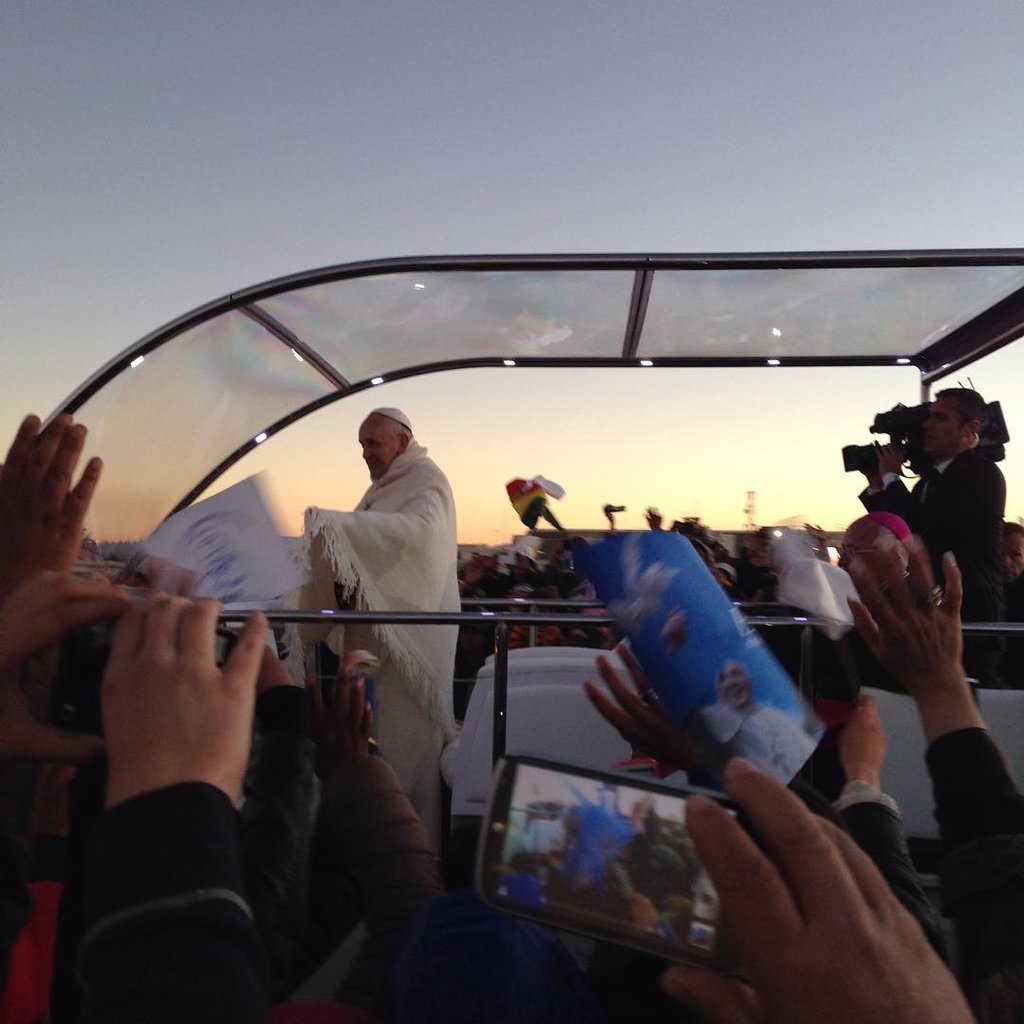
Spectators reached out for Pope Francis as he drove by.
Q&A: Pope's Ability to Connect
July 10, 2015
Q. I write books and articles on communication skills. I've written about Pope Francis. In your travels with him, what strikes you about his ability at public speaking and to move an audience?
From Carmine Gallo, via Facebook
A. Carmine, interesting question. He is not always especially animated or charismatic, as we might define it in the USA. Yet he has quite a hold on people when he speaks. His homilies and comments are concise and deeply thought out. And he seems to connect with the audiences here. He tells little jokes, and the people laugh. And he conveys a humility that seems to resonate.
Pope Francis May Have to Confront Bishop Controversy
July 10, 2015
Later today, Pope Francis may have to confront one of his most controversial moves in Latin America. Despite widespread protests in Chile, Francis in March approved the installation of Juan Barros as bishop of Osorno, a city about 500 miles from the capital of Santiago.
Bishop Barros has been accused by some Chileans of complicity in a horrific clerical sex abuse scandal – involving a former priest, the Rev. Fernando Karadima. Bishop Barros has denied all accusations against him and has not been charged with anything, but many Chilean Catholics are furious over his appointment, especially in Osorn
This afternoon, Francis is attending the second World Meeting of Popular Movements in Santa Cruz, Bolivia, a gathering of global organizations that work on behalf of the poor and marginalized.
Three people from Osorno are attending and hope to present Francis with a letter asking him to rescind the appointment of the bishop.
The letter asks: "How can the Pope who has announced zero tolerance for child molesters, and those associated with them, designate as bishop of Osorno someone who is implicated in covering up the sexual abuses of the worst pedophile in the history of the church in Chile, as was Fernando Karadima?"
Francis has taken tough steps against clerical sex abuse, establishing a powerful Vatican commission to address the issue and also creating an agency to investigate and prosecute wrongdoing by bishops on such cases. But the case in Chile is one that puzzles even some of Francis' most ardent supporters.
For a comprehensive look at the issue, read this excellent piece from National Catholic Reporter.
Q&A: Pope's Past Influence on Latin America
July 9, 2015
Q. As a cardinal in Argentina, how much did the pope travel to other Latin American countries, and what was his influence on the continent then?
From Hal Hershey, via Facebook
A. Hal, Francis began as a very influential figure in Latin America. As a Jesuit leader, he sent young students to Ecuador for training and made contacts there. But his biggest moment came in 2007, when Latin American bishops held a pivotal meeting at Aparecida in Brazil. He became the leader of the group and oversaw the drafting of a document that outlined the vision for the Latin American church — and has influenced his papacy.
'Charismatic' Churches Try to Woo Catholics
July 9, 2015
One of Pope Francis's biggest challenges in Latin America is drawing people back to the church. Protestant congregations are growing rapidly, partly because they offer more vibrant, emotional religious services. But many Catholic dioceses in Latin America have also been embracing this style of worship, which Francis has praised. He even tried a little call-and-response at his outdoor Mass in Quito.
My colleague, William Neuman, has a smart look at the rise of these "charismatic" Catholic churches.
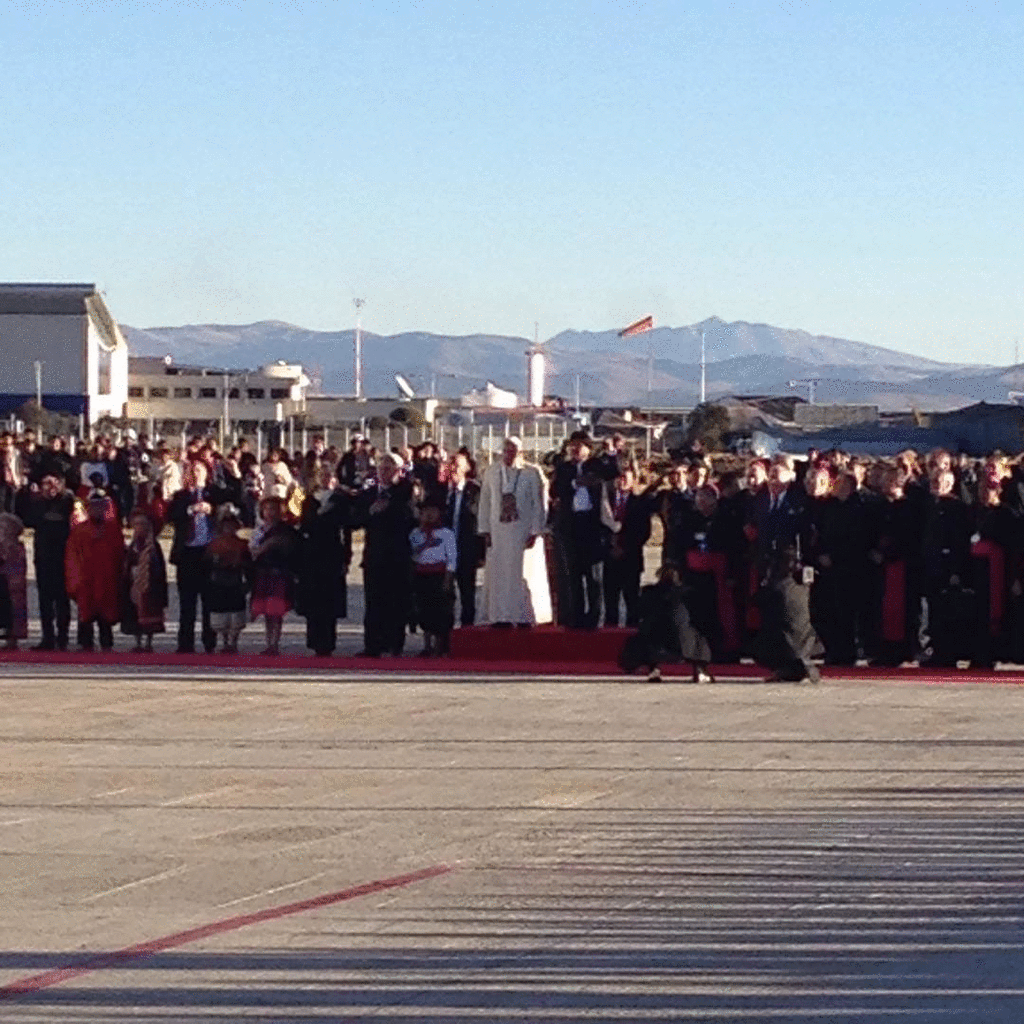
Pope Francis arrives in La Paz, Bolivia.
Gifts Reveal Complicated Relationship
July 9, 2015
Pope Francis is now in Bolivia, where it has been fascinating to watch his interactions with President Evo Morales. They are two men with reason to be wary of one another – yet who, for different reasons, are working to cultivate a relationship.
Mr. Morales is a fiery leftist, born to a poor Aymara indigenous family, who has long been contemptuous of the Roman Catholic Church and its history of complicity in oppressing the indigenous populations in Bolivia. Bolivia is nearly 85 percent Catholic, yet Mr. Morales has declared it a secular state.
But the Bolivian leader has moved to develop a bond with Francis, the first Latin American pope, who has made the plight of the poor central to his papacy. Mr. Morales has visited Francis in Rome, and he greeted him Wednesday afternoon at the La Paz airport. In his welcoming speech, Mr. Morales criticized the church's past but praised Francis for sharing his goal of helping the poor.
"He who betrays a poor person, betrays Pope Francis," Mr. Morales declared. And this morning, Mr. Morales even attended Francis's huge outdoor Mass in Santa Cruz, offering him a warm, smiling handshake for all to see.
Francis has returned the good will, lauding Bolivia for making "important steps" in the country's "economic, social and political life," while praising the values and importance of indigenous culture during his visit. But he has also stressed the critical role that the church can, and must, play in Bolivia.
The complicated nature in the relationship was evident in the gifts they exchanged: Mr. Morales gave the pope a wooden cross carved in the shape of a hammer and sickle, the emblem of global communism. The pope gave Mr. Morales a copy of "Laudato Si'," his environmental encyclical. The Bolivian president, a champion of the rights of indigenous people and their relationship with the land, has faced recent criticism about road building in ecologically fragile regions.
The two men are expected to meet again later today at the Second World Meeting of Popular Movements, a gathering of organizations representing people on the margins of society. Mr. Morales came to Rome for the first meeting last October.
Meeting a Sea of People in Bolivia, and Its President
July 10, 2015
Pope Francis begins his first full day in Bolivia on Thursday with a huge outdoor rally in Santa Cruz. The crowds are expected to be enormous, and the pope has other stops, including meetings with seminarians and religious groups. He will also attend a world conference of popular movements.
It was interesting to watch yesterday's interplay between Francis and President Evo Morales of Bolivia. Mr. Morales has been a sharp critic of the Roman Catholic church and its historic role in Latin America. But he likes Francis and recognizes his influence in the continent. Francis, in turn, wants to strengthen relations with Mr. Morales in a country like Bolivia, which has many Catholics.
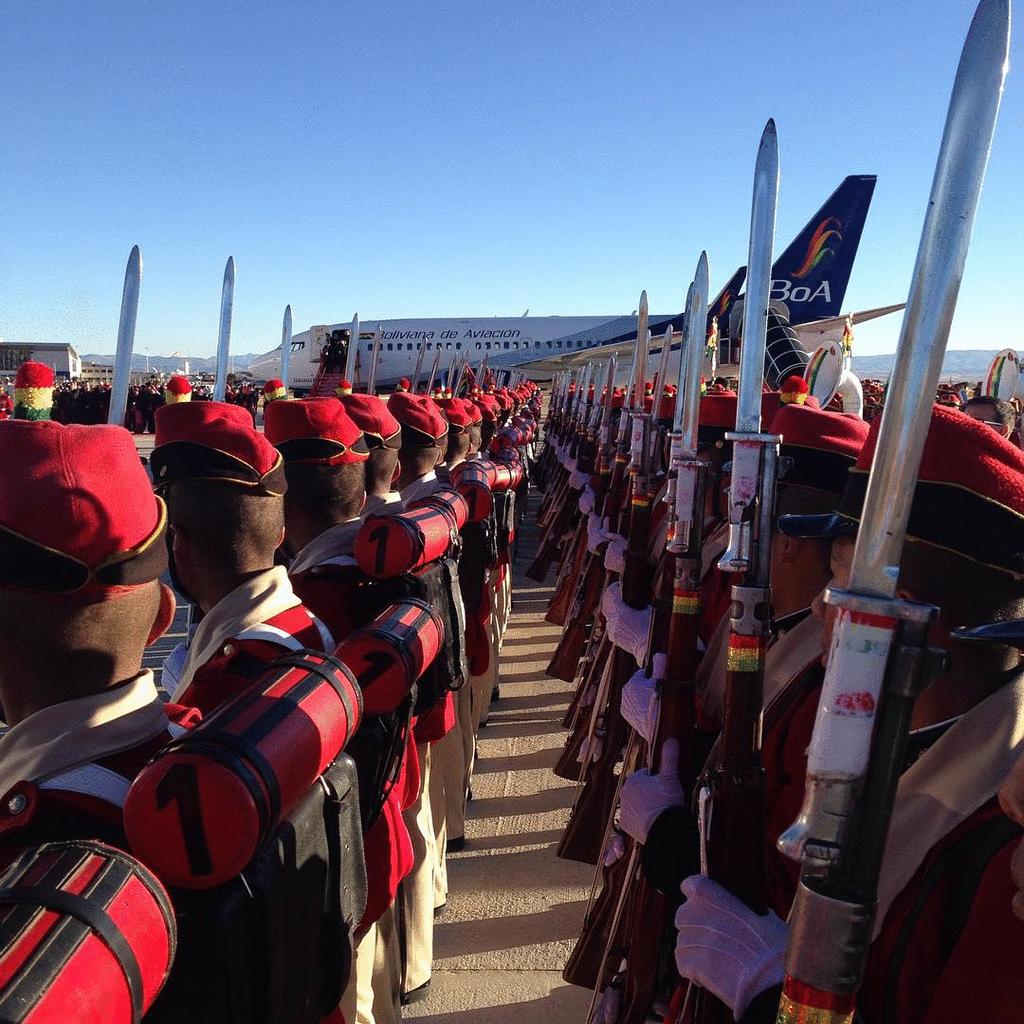
A Bolivian Welcome for Pope Francis
July 8, 2015
Bolivian soldiers stood in formation to welcome Pope Francis on the tarmac in La Paz earlier today. President Evo Morales greeted the pope at the airfield.
A makeshift facade of a cathedral was constructed in front of the hangar. Francis and Mr. Morales spoke from there before a large crowd, most of them indigenous peoples.
'Social Media Is the Only Freedom That We Still Have'
July 9, 2015
On Tuesday night, I was crawling into bed, exhausted, when I checked my Twitter feed and noticed a post, with photographs, addressed to me. Protesters were holding candles and waving Ecuadorean flags in the photos.
happening now at the Hotel entrance. Ecuadorian Journalist for PressFreedom PLS Listen
I sighed. My hotel bed was comfortable. Maybe this was just a prank.
I got dressed, took the elevator to the lobby and checked the front door. Nothing. Inside the expansive media center provided for reporters traveling with Pope Francis, desserts were arrayed on a table. Several journalists were still filing stories. Normal. Another hotel entrance was nearby, but a security officer had blocked it by erecting a temporary wall decorated with images of Francis.
Odd.
I wiggled around the wall but saw nothing suspicious. I sent a response on Twitter from the lobby and returned to my room:
just walked downstairs but didn't see anyone
I got back in bed and made another final check of my phone. Another Twitter message awaited, this one with a photo showing the wall I had wiggled around. I hadn't looked hard enough.
The journalists about 80 are on the street. MainEntrance
Clothes back on, down the elevator again, this time with genuine curiosity. Outside the hotel, I found five people holding one Ecuadorean flag, the stragglers from the larger rally in the original photograph. I told them social media must still be free, given how they had tracked me down. They laughed.
"Social media is the only freedom that we still have," said Maria-Laura Patiño, one of the group.
With the world's media at their doorstep, they had staged a small demonstration outside our hotel to draw attention to one of the ironies of Francis' trip to Ecuador. Even as the government has treated us like visiting dignitaries, journalists in Ecuador are under intense pressure. Ecuador's Constitution provides freedom of expression, but civil society leaders say the reality is far different, as newspapers and journalists critical of the government of President Rafael Correa can face legal prosecution and other pressures.
"We are just citizens," Isabel Proano told me, "and we wanted to bring attention to the issue of freedom of expression – which we had none of."
We talked for a while and they wandered home, as I returned to my room and flipped open my laptop to search "Ecuador" and "freedom of expression." I had known that the Correa government had been criticized for quashing dissent, but the search results were revealing.
Freedom House, the global watchdog organization that ranks countries on freedom of expression, rated Ecuador this year as "not free". It accused Mr. Correa and other political leaders of creating a hostile environment for the media, and using a 2013 communications law as a tool to intimidate and legally sanction critics in the media. Mr. Correa also has filed several criminal and civil defamation cases against critical journalists.
Next, I found a news release by the Committee to Protect Journalists, dated June 16, barely three weeks before Francis arrived. It described how Ecuador's state media oversight commission had fined an independent daily newspaper, El Universo, about $350,000.
Why? In March, El Universo published an exposé alleging problems at state-run hospitals. Journalists attempted to interview the government official in charge but got no reply. The day after the story was published, Mr. Correa criticized it on Twitter, arguing it had failed to allow a government response. Doing so, under Ecuadorean law, is punishable.
A government minister ordered El Universo to publish the state's long rebuttal. The newspaper complied, but wrote its own headlines and did not publish government-drafted summaries that claimed the original story was designed to trick readers. Boom. A $350,000 fine.
You can find example after example if you keep searching.
I was reminded of one of the inevitable compromises of being inside any traveling media bubble. You go through a country, but you are not really in it.
The traveling papal media gets trays of empanadas and sliced fruit. The locals get fined.
An Impression of Ecuador, Drawn at High Speeds
July 8, 2015
Part of what this multiplatform experiment in covering a papal trip is intended to offer is a touch of travelogue, a feeling and sense of these distant places where Pope Francis visits. But in Ecuador, I can only offer a superficial impression, drawn at high speeds, often while staring through the windows of a media bus as we race after the pope, and he races past the adoring crowds.
People. They seem to be everywhere, lining every road. People crowded under umbrellas in a square in Quito's lovely historic center on Tuesday night, just because Francis was going to drive through and offer a few words, before continuing to the Church of St. Francis.
I'm told the crowds in the Philippines were bigger when Francis visited, but the Philippines is much more populous.
Here, it feels like Quito is closed down, nothing is happening, other than an entire city is on the streets and receiving the Latin American pope. The crowds are so thick in its center that yellow-vested police officers must hold everyone back – or risk that our buses might run someone over on the narrow roads.
We spent a day in Guayaquil – a different world, humid and tropical, rivers thick with brown water spilling over the banks, located on the Ecuadorean coast. The sun pounded down with the pitiless fury of April in northern India. Yet the people came out, under umbrellas or hats, or under the beating sun. It was a party. It was a vigil. It was a Mass.
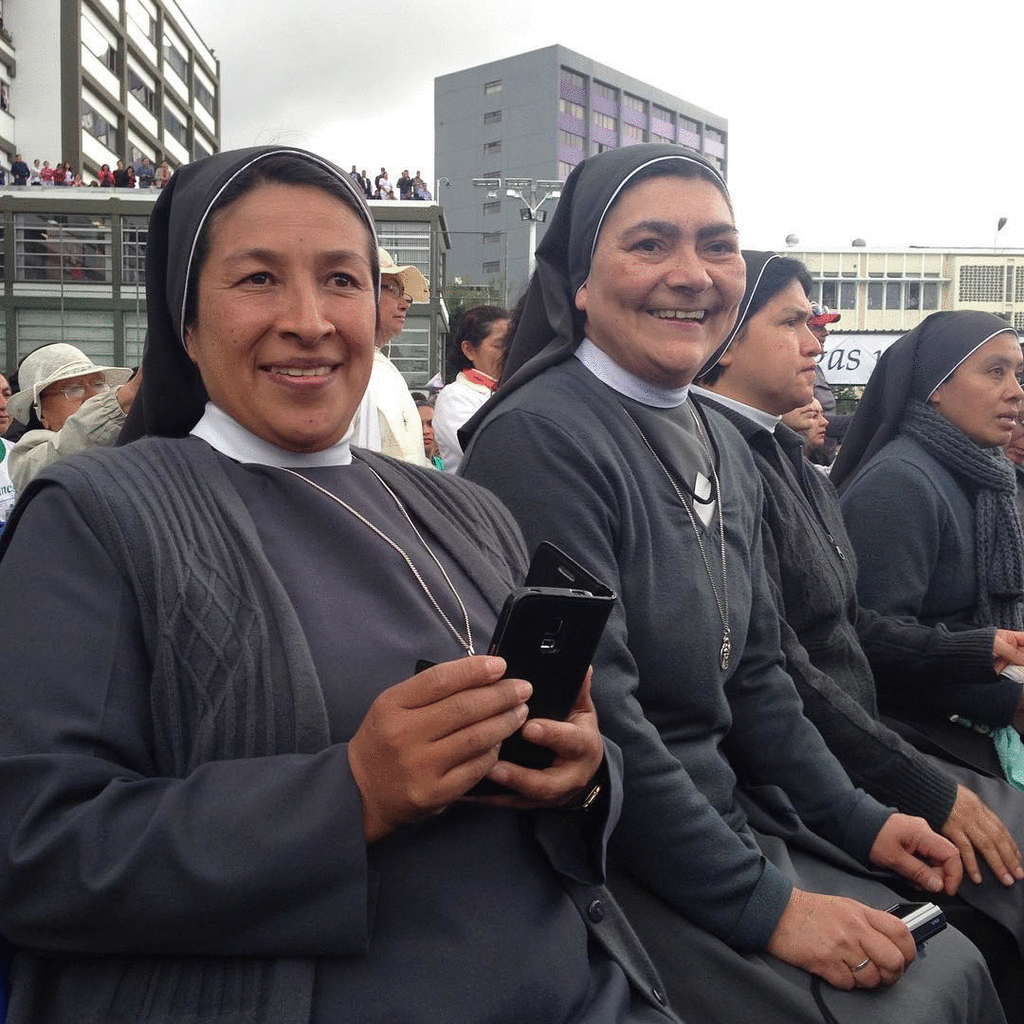
Nuns wait to see Pope Francis in Ecuador.
An Endless Wave of Adulation
July 8, 2015
We will leave Ecuador in a few hours and fly to Bolivia. Pope Francis is making his final stops, visiting the elderly and speaking at a major Marian shrine outside Quito.
For many of these events, a chosen pool of reporters travels with the pope, while the rest of us are stationed in nearby press centers, studying our advance copies of his planned remarks, watching everything on television and filing stories. Right now, I'm sitting in the waiting room at the Quito airport with dozens of other journalists as we watch footage of Francis standing in the popemobile as he is driven, yet again, through a parade route crammed with people.
They throw flowers at him, or chant his name, or raise cellphones and snap photos. I saw one mother slip through the metal fencing lining the road and present her child toward the oncoming popemobile. The driver slowed, and Francis leaned over and gave his blessing.
The popemobile moves surprisingly fast. Francis, who is 78, grips a metal bar and shifts from side to side, offering blessings and waves. The faces along the roadsides must blur together, everyone smiling and shouting, an endless wave of adulation and humanity, disorienting in scale if overwhelming in affirmation.
It is easy to forget in the secular media that he is here to evangelize, and these drive-bys, if seemingly corny or artificial, represent the only chance for many ordinary Catholics to see the pope.
And that is what many people simply want. To see him. Families have waited in the rain just for the chance to catch a glimpse of him at the huge outdoor masses, even if the stage is hundreds of yards away.
I was inside the Church of Saint Francis when the pope arrived on Tuesday night. It was filled with people, and I stood beside a woman and her elderly mother. The mother was in the wheelchair, and she wanted to see the pope, but the people rose, cameras in the air, and she couldn't see over. So as the meeting started, and people sat down, the daughter and I reached under her mother's armpits and lifted her. And for a moment, she got to see the pope.
When in Bolivia...
July 8, 2015
One question is whether Pope Francis will chew coca leaves in La Paz. The United Nations declared coca leaves – the raw material of cocaine – to be an illegal substance in 1961. Bolivia, however, allows coca cultivation for religious and medical reasons, and many of Bolivia's indigenous peoples chew coca leaves to compensate for the altitude. They also consider it a sacred plant.
Francis has asked that coca leaves be available to him in La Paz, perhaps as a gesture of solidarity with the native people. We'll see if he actually chews one.
Pope Francis Makes Last Stop in Ecuador, Then to Bolivia
July 8, 2015
Today is our last in Ecuador. Pope Francis is paying a morning visit with Roman Catholic religious groups and seminarians at an important Marian shrine in the nearby town of El Quinche. Then we fly to La Paz, in Bolivia.
We are spending only four hours in La Paz, mostly because of the altitude, before flying to the Bolivian city of Santa Cruz. La Paz is the highest administrative capital in the world, and I'm told the airport sits at 4,100 meters, or about 13,450 feet. Francis lost part of a lung to an infection as a teenager, and a medical staff member is traveling with him.
Francis does not seem too concerned. When he became pope in March 2013, some analysts questioned whether his health might limit his overseas travel. Apparently not. He has already been to Albania, Brazil, the Holy Land, the Philippines, Sri Lanka, South Korea and Turkey, and he has made several trips inside Italy.
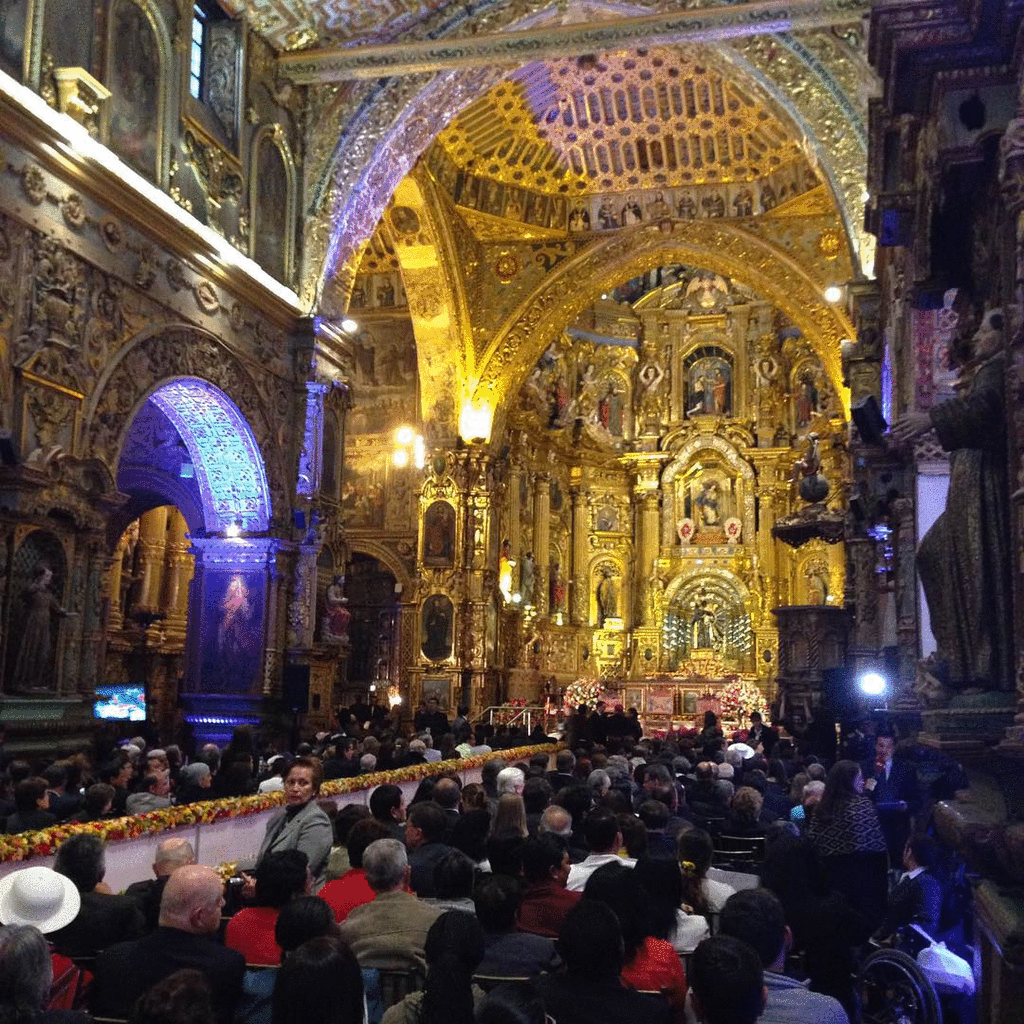
The Church of Saint Francis, a 16th century cathedral in the Ecuadorean capital.
Visiting a Baroque Cathedral in Quito
July 8, 2015
Last night, Pope Francis addressed civil society groups inside the Church of Saint Francis, an immense baroque cathedral in Quito, Ecuador.
Pope Francis Challenges Ecuador on Protecting Amazon
July 8, 2015
Pope Francis delivered his first big environmental message of his trip on Tuesday, calling on Ecuador to protect the Amazon rain forest — even as President Rafael Correa is pushing ahead with oil exploration.
Francis and Mr. Correa have been dancing an odd minuet on this trip, as the president wants to reap the benefits of the pope's popularity even as he is facing rising opposition at home for his economic and environmental policies.
Here's the article I wrote on this.
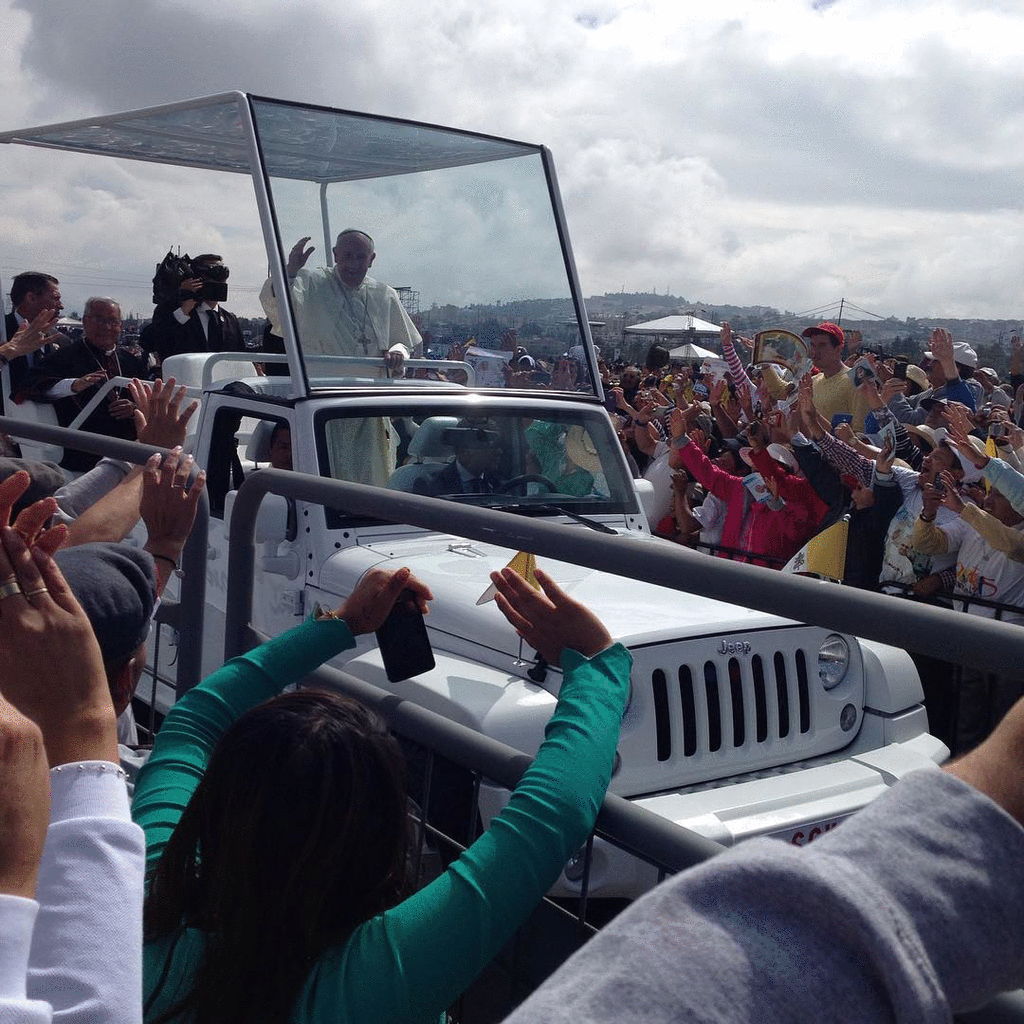
Pope Francis arrives at Bicentennial Park in Quito and immediately does a lap through the massive crowd in his popemobile.
Pope Francis Calls for Unity at Huge Mass
July 7, 2015
For the second straight day, Pope Francis offered an enormous outdoor mass in Ecuador on Tuesday, this time in Quito, the capital, at the city's former airport, since renamed Bicentennial Park. Francis seized on the name of the park to say it harkened back to Latin America's "cry for independence" from colonialism more than two centuries ago.
Francis spoke about the divisions of that historic era, noting that South America was only liberated after leaders put aside rivalries. The first pope from Latin America, he called on the people of his native continent to find unity, saying that the Roman Catholic Church, and evangelizing, could be unifying tools.
"There was no shortage of conviction or strength in that cry for freedom, which arose a little more than 200 years ago," he said. "But history tells us that it only made headway once personal differences were set aside, together with the desire for power and the inability to appreciate other movements of liberation."
The crowd was huge. Some people had slept outside overnight, despite the cold and rains on Monday.
President Rafael Correa of Ecuador attended the Mass, despite having suggested previously that he might skip it to avoid confrontation with potential protesters. His leftist government has faced large protests over the last month.
Midway through the Mass, a few isolated people could be heard shouting, "Get out!" a slogan that demonstrators have used to call for Mr. Correa's ouster, but the cry was not taken up by others in the crowd.
Early on, there was brisk applause from those near the altar when Francis mentioned how colonial-era Latin Americans were "subject to the passing whims of whoever was in power at the moment."
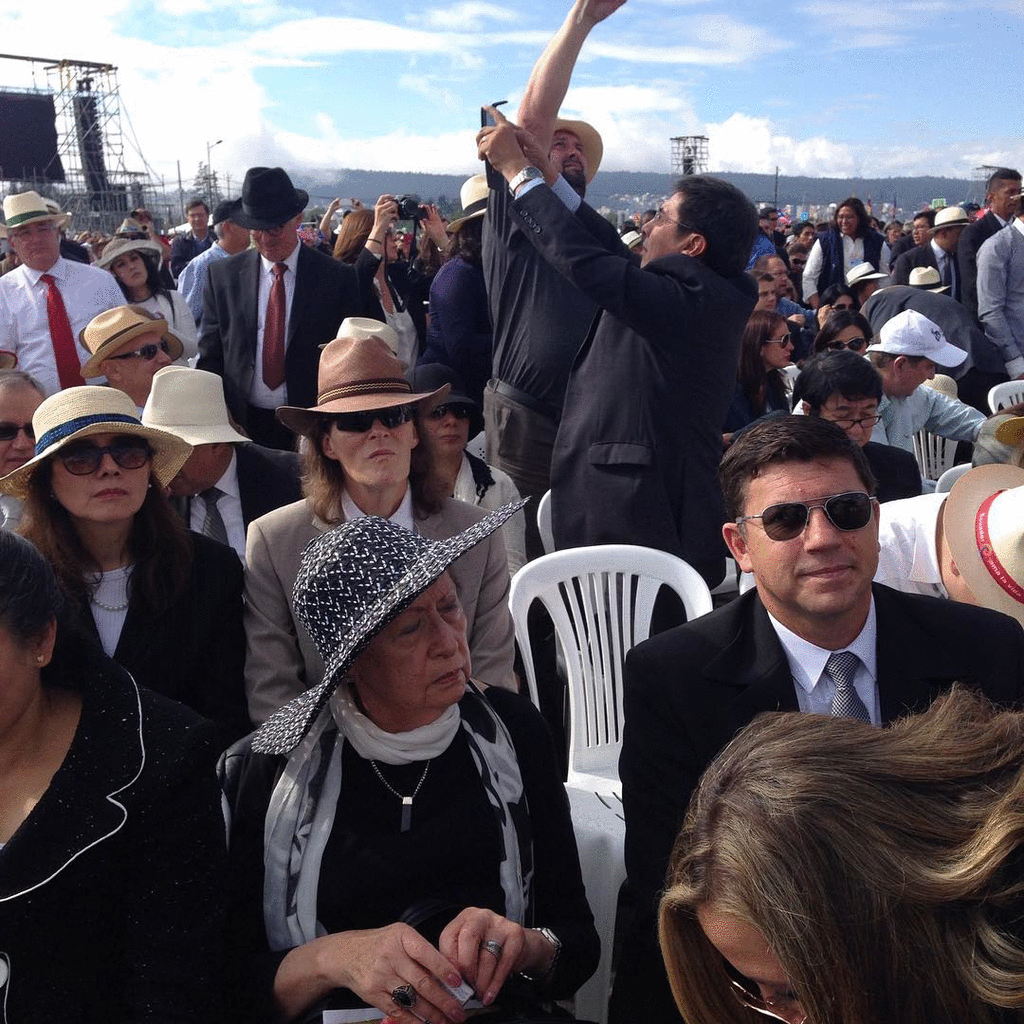
A good day for a hat.
Anticipating Pope Francis
July 7, 2015
An estimated 1.5 million people are expected for Tuesday's Mass with Pope Francis in Quito, Ecuador.
Pope Francis Parachutes Into Political Turmoil
July 7, 2015
On Monday night, Pope Francis met in Quito with President Rafael Correa of Ecuador for a private chat at a delicate moment. For weeks, protesters have demanded the president's resignation. Some are furious over his proposals to redistribute wealth and property. Others say that Mr. Correa is trying to weaken Ecuadorean democracy. His supporters strongly disagree.
It is hard to know what Francis thinks about the president, or whether he thinks Ecuadorean democracy is in trouble. He hasn't said yet, and he may not bring it up.
Francis's visit to Ecuador, which continues Tuesday in Quito, is a milestone event for a small country, but it also illustrates the perils for any pope parachuting into political turmoil. Especially Francis. As the first Latin American pontiff, Francis is now one of the most revered, and powerful, figures on the continent. And as the "pope of the people" or the "pope of the poor," Francis has branded himself as a voice for the powerless, not the powerful.
Ecuador's political turmoil escalated in the weeks before Francis's visit with middle-class protests against proposed changes in inheritance taxes. But Mr. Correa has also been criticized for curbing press freedoms and trying to discredit human rights groups. He sees himself as leading a leftist citizens' revolution.
During Francis's visit, Mr. Correa has unabashedly sought to wrap himself in the pope's popularity. He was waiting at the airport when the pope arrived in Quito on Sunday. (In a speech on the tarmac, Francis noted to Mr. Correa, in an interesting little joke, that "you have quoted me too much.")
And during the meeting Monday night in the presidential palace, Mr. Correa organized an elaborate event. At one point, he shepherded the pope onto the balcony before the masses gathered in the square. Even as Mr. Correa smiled broadly, at one point doing a little jig, Francis kept a small distance. But it is an image the president can use to suggest, rightly or not, that the pope is on his side.
Inside the palace, Mr. Correa guided the pope down a receiving line that seemed to stretch to infinity, carefully introducing Francis to each and every dignitary. Outside, the crowds watched it all on large televisions until Francis finally left the palace – and Mr. Correa – and went to stand in front of the city's cathedral and address the cheering people.
On Tuesday, Francis is holding a huge outdoor rally in Quito. Then he will meet with leaders of Ecuadorean civil society, including groups for indigenous populations. Before the trip, Vatican officials said peace and democratic development would be central themes, as well as service and unity. Some civil society groups in Quito have been critical of Mr. Correa.
It will be interesting to see what the Latin American pope says to them.
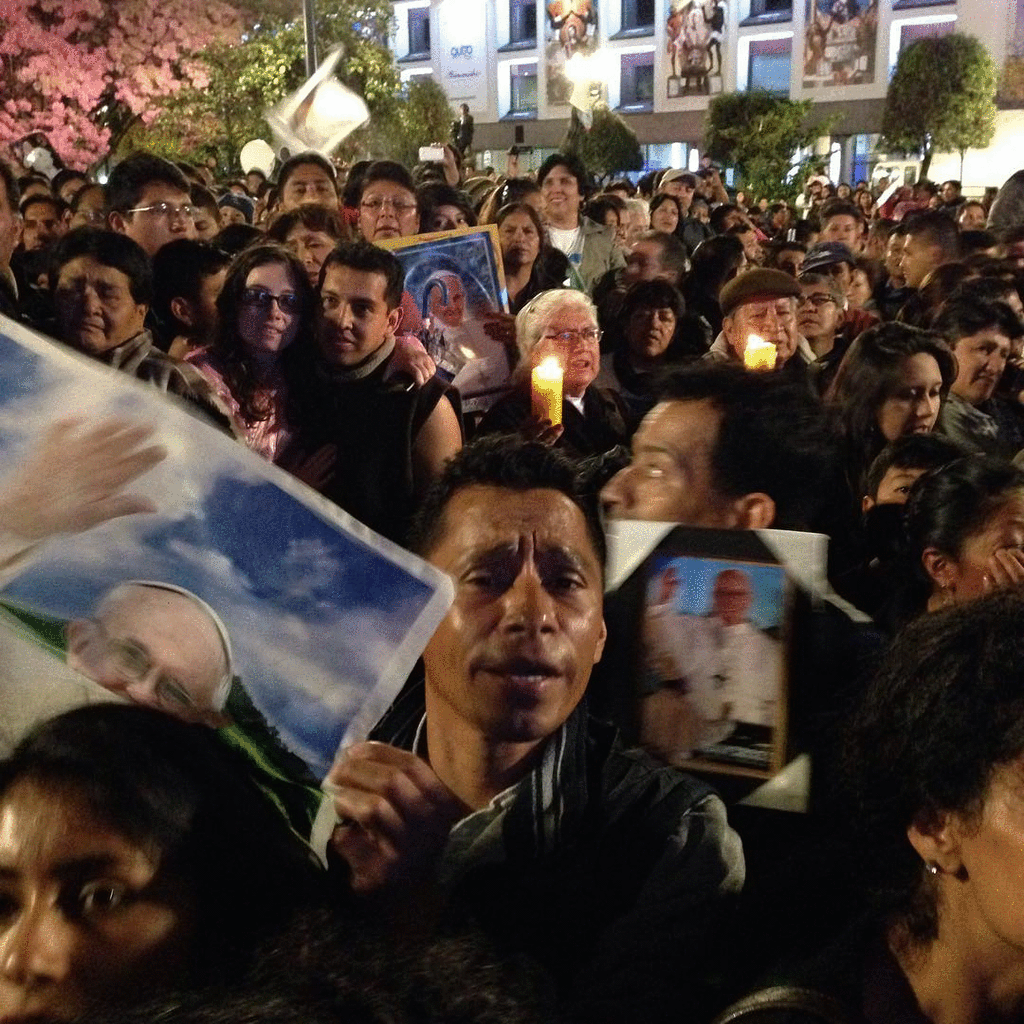
The crowd at Plaza de la Independencia in Quito, Ecuador, on Monday evening.
Waiting for Pope Francis
July 6, 2015
People were gathering at Plaza de la Independencia in Quito, Ecuador, on Monday evening to await Pope Francis. He was nearby, inside the presidential palace, meeting with President Rafael Correa.
Pope Francis Focuses on the Family
July 6, 2015
Pope Francis is expected to discuss a variety of issues on this trip, but his first major address focused on family and the church's obligation to embrace the excluded.
Hundreds of thousands of people gathered in a dirt field in Guayaquil on Monday as Francis also asked for their prayers as he readies for a pivotal meeting in October at the Vatican in which church leaders will grapple with issues such as how the church should receive divorced or gay people.
William Neuman and I filed a story from the outdoor Mass, and Willie even found hawkers selling Francis headbands.
Pope Francis Connects With His Past in Guayaquil
July 7, 2015
The papal motorcade raced down the highway and exited into a neighborhood in the Ecuadorean port city of Guayaquil. At one point, the cars slowed because so many people were pressing into the road. Police officers lined the streets. People waved flags.
Then the motorcade pulled into a Jesuit school, leaving the crowds behind. Pope Francis had arrived for a private lunch on a public day. (Television news crews in helicopters hovered overhead until Francis was seen walking inside.)
A Jesuit himself, Francis visited the school, Colegio Javier, to relive a bit of his past. Decades ago, Francis (then Jorge Mario Bergoglio) led the Jesuits in Argentina and then became the rector at a Jesuit college. Usually, he kept his students in Argentina, according to Austen Ivereigh, one of his biographers. But he made an exception for Colegio Javier in Guayaquil.
"He trusted the spiritual and intellectual regime there," said Mr. Ivereigh, author of "The Great Reformer: Francis and the Making of a Radical Pope."
He also became friends with the rector, a Spanish Jesuit named Francisco Cortés, known locally as Father Paquito. At one point, Father Paquito traveled to Argentina for the ordination of a couple of students who had studied with him in Guayaquil.
Now 91, Father Paquito still lives at the school. He hasn't seen Francis in 30 years, and he told the local media in Guayaquil that he was astonished that the pope was so determined to see him. Francis had many difficult moments in Argentina during his leadership of the Jesuits, and scholars say he has sought, as pope, to restore good will.
"I see this visit as part of the same process of reconciliation with his Jesuit past which he began after his election as pope," Mr. Ivereigh said in an email. "But more particularly and personally, it's his last chance to see Padre Paquito, who is very frail."
Note: An earlier version of this post misidentified the flag waved when Francis's motorcade passed. The flag represents the city of Guayaquil. It is not an Argentine flag, although they are similar. Thanks to @jmatheuss for sending me a note on Twitter about this.
Live From Guayaquil
July 6, 2015
@jimbyardley, via Twitter:
We're now in Guayaquil, Ecuador's biggest city and Francis has been engulfed by people. On the streets watching his procession. 1/2
And in a dirt field where hundreds of thousands of people are waiting in a boiling sun. He has just arrived. Incredible spectacle. 2/2
The outdoor mass has started. Francis arrived wearing vestments stitched by local nuns. Big, big crowd.
If Catholic church wants people back in pews in Latin America, it is working today. It seems like the whole city is here or on streets
The Trials of Working With Prepared Remarks
July 6, 2015
It is 5:15 a.m. in Quito, Ecuador, and still dark outside as a group of journalists gather outside a room in the Hilton Colón. This is how the work of covering Pope Francis begins. Reporters collect the texts of prepared remarks for the pope's speeches today in the Ecuadorean city of Guayaquil.
One of the pope's press aides, Matteo Bruni, wins the task of handing out the speeches. The agreement is that no one can publish anything until after Pope Francis has delivered the speeches. Getting the texts is critical because journalists need to get a sense of what the pope is going to talk about so that they can begin drafting stories – or at least parts of them – in advance. Having the prepared remarks means that reporters, especially for the wire services, are ready to put something up almost immediately after a papal speech. For the Vatican, it is intended to ensure that the articles are accurate.
But there are risks, especially with this pope. Atop the advance copies is the word EMBARGO and the phrase "check against delivery." Pope Francis likes to go off script, and often those off-script remarks are especially interesting, or even the most telling.
So the advance text becomes a guide. Reporters read it while Francis speaks, and then hurriedly scribble in the margins when he goes off topic. He did it a few times on Sunday at the airport welcoming ceremony.
The final challenge is language. The pope usually speaks Italian at appearances in the Vatican and in some other countries. But in Latin America, he speaks Spanish.
Most members of the news media corps who write about the pope can follow in Italian, but not everyone can in Spanish, especially if he uses Argentine colloquialisms. So fluent speakers of Spanish flag the pope's diversions from the prepared remarks and help everyone else. The Times also has correspondents in Latin America who are fluent in Spanish and who are helping to cover the visit, providing an extra safeguard for us.
The Pope's Arrival in Quito
July 6, 2015
Rolling out the red carpet in Quito, Ecuador, for Pope Francis on Sunday. Here's a clip from the welcoming ceremony.

Pope Francis
Greeting Pope Francis, at 30,000 Feet
July 6, 2015
Somewhere over Spain, the flight attendants suddenly began taking our breakfast trays. We had just finished a sampler of fruit, yogurt and prosciutto, and I was trying to resist an irresistible desire to go to sleep. Then one of the pope's aides, Matteo Bruni, appeared, as did the Vatican spokesman, Rev. Federico Lombardi. Camera crews got positioned along the aisle. The grey curtains dividing the papal jetliner were pushed fully open and Pope Francis stepped into the media section at the rear of the plane. He was dressed in white and smiling.
It is a bit surreal to see the pope while hurtling across the sky at 30,000 feet. From a distance, I had watched him conduct the New Year's Eve vespers service at St. Peter's Basilica, but to my straining eye in the giant cathedral he was just a small figure in white, at the center of things. Now he was six miles up and only a few feet away.
He is 78, but looks younger than I expected, and more vigorous. He seemed excited, perhaps because he was going home (or at least to his home continent, if not his native Argentina). He knew several of the Spanish-speaking journalists and paused for a kiss on the cheek from one woman.
This appearance, I've learned, is a Francis ritual. He begins each international journey by visiting with the accompanying reporters and offering a few benign remarks, in this case wishing us well with our work. He must understand the cardinal rule of political messaging – do not step on your message before you deliver it. Pope Benedict XVI learned this the hard way, when advance remarks he made ended up overshadowing a few of his trips. Francis does the interviews at the end, holding forth in free-wheeling sessions on the return flight to Rome.
But Francis does work the room. This morning, he shook hands with every journalist, posed for photos and, in some cases, offered blessings. Matteo moved with him, introducing each journalist. When they reached my seat, on Row 41, Matteo introduced me, and Francis smiled and shook my hand. I said a short hello in mediocre Italian, and he kept moving. I couldn't help noticing his eyes. They seemed to crackle.
He seemed especially pleased with my seatmates, a group of journalists from Paraguay and Bolivia. A Paraguayan woman brought letters that she had promised to deliver and a rosary for Francis to bless, which he did. A television journalist from Latin America handed him a small plaque and regaled him with a story. Francis would receive a gift, pause to take a look or to ask a question, and then reflexively hand it back to a trailing aide.
Sitting near me was Cecilia Dorado, a journalist at Periodico El Deber, a Bolivian newspaper. More than a few of us were tentative in approaching the pope. Not Cecilia. She presented him with a wooden cross and asked if he would join her for a selfie. He chuckled and nodded, as if to say, "Why not?"
Eventually, Francis finished his rounds and returned to his seat. A few television reporters jumped up and began doing stand-ups in the aisle.
Pleasantries over, the story had now begun.
Challenges Facing Pope Francis in Latin America
July 4, 2015
My alarm is ringing at 4 a.m. on Sunday, so I'm trying to get ready for the flight tomorrow morning to Quito, the capital of Ecuador. My colleague, William Neuman, is already there – he is based in Venezuela and covers the Andes region for The Times – and he has filed an interesting piece about the challenges that Pope Francis faces in bringing people back to the pews in Latin America.
When he visited Brazil in July 2013, Francis electrified the nation. He celebrated his final mass at Copacabana Beach in Rio de Janeiro, marking World Youth Day. It was attended by more than a million people.
Francis will certainly draw big crowds again on this trip. But for the Roman Catholic Church, one of the bigger questions will arise after he leaves: Will people come back to the Catholic fold?
Great piece by Willie, so take a look.
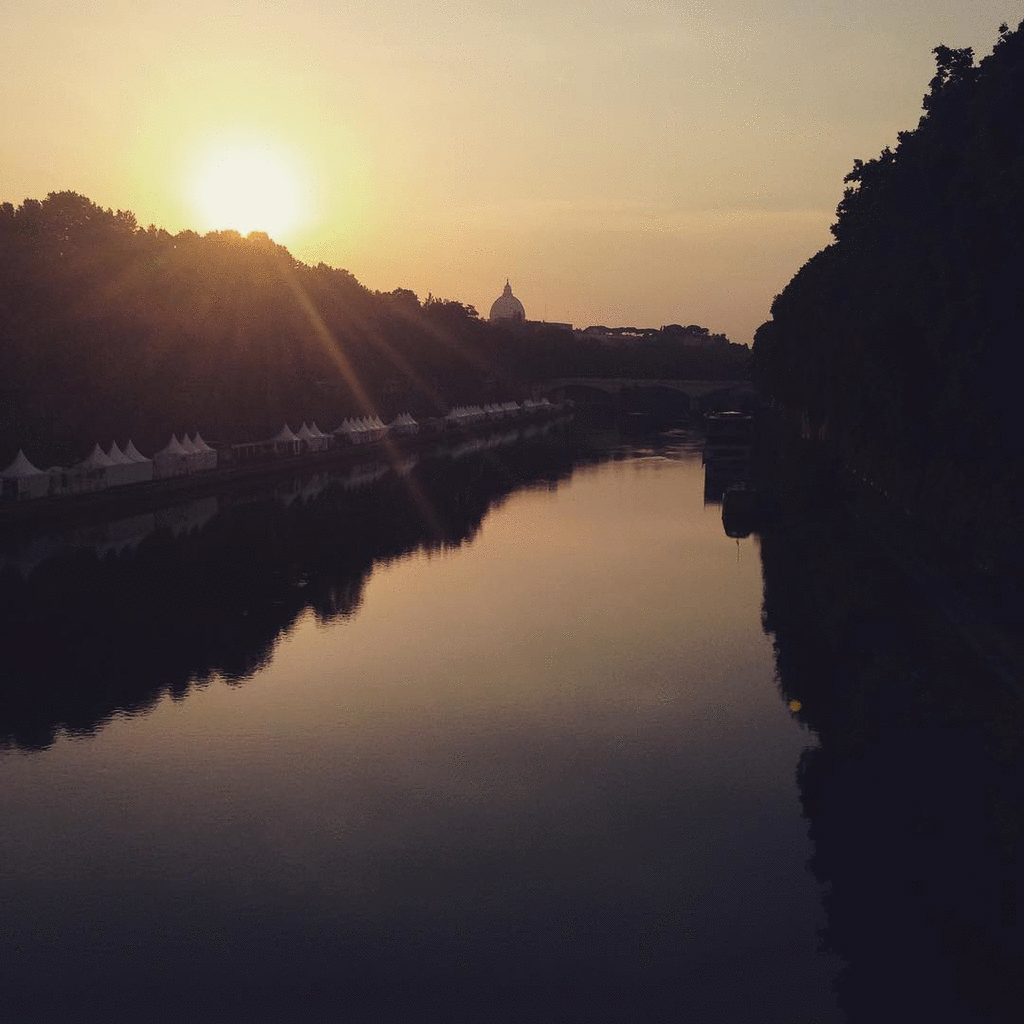
Sunset over the Tiber and the dome of the Vatican in the distance. This was taken from the Ponte Sisto, the ancient bridge I walk across every day to go to work.
A Message in the Pope's Itinerary
July 4, 2015
I've been a foreign correspondent for 12 years, working in places like China, Mongolia, India, Bangladesh and Nepal, to Italy, Greece, Germany, Spain, Cyprus, Malta and a few other countries. I've been to Africa. But I've never been to South America, so I'm really interested to observe the similarities and differences, especially with Asia.
For Francis, this is a big moment, given that he is the first pope from Latin America. He traveled to Brazil shortly after becoming pope, but that trip had already been scheduled for Pope Benedict XVI before his unexpected resignation (which led to the election of Francis).
So this is the first time Francis is setting his own itinerary on a South American trip. By traveling to three small, poorer countries, he is staying true to the pattern of his trips in other regions, in which he skirted more powerful countries and stopped in places like Sri Lanka and the Philippines, or even Albania. I assume his message is that so-called peripheral countries are not peripheral to him.
Touring With Pope Francis After 'Laudato Si'
July 6, 2015
Before I ran off to Greece, I had spent the week in Rome and Vatican City covering the release of Francis's first major encyclical, "Laudato Si'," which addressed the environment and its impact on the poor. Let's be honest: papal encyclicals aren't usually big global news. But this was quite incredible.
Environmentalists and global organizations around the world were praising the encyclical as a major moment in which the moral weight of religion – from one of the world's leading religious figures – was being aligned with the fight against climate change. But critics saw Francis as naïve and wrongly inserting himself into the world of science.
I expect Francis will find moments to promote his environmental position during the trip (such as advocating protection of the Amazon), but his message will be broader. Vatican spokesmen, briefing reporters last week, noted that all three countries on the itinerary were once ruled by military regimes and have been the settings of several wars. Francis is coming with a message of peace and democratic development, the Vatican said.
I also wonder if he is coming with some altitude sickness pills. (I am.) The altitude at the airport in La Paz, the Bolivian capital, is 4,000 meters -- nearly 12,000 feet.
Confusion Gives Way to Enthusiasm
July 4, 2015
Now that Francis is a so-called rock star pope, it is easy to forget that much of the world initially had no idea who he was. In March 2013, I was standing in St. Peter's Square when the white smoke came out of the chimney affixed to the Apostolic Palace. There was so much anticipation, and everyone thought the new pope would be a young, dynamic reformer.
But when he stepped onto the central balcony of St. Peter's Basilica, the crowd's immediate reaction was confusion. The new pope was Jorge Mario Bergoglio, the former archbishop of Buenos Aires. He was 76. Almost none of the handicappers had even considered him a contender. Tens of thousands of people had been waiting in the rain, and everyone seemed disoriented. I stood with two disappointed Roman priests who basically said: Who is this old guy from Argentina? If only we knew.
Francis seemed stiff, possibly a bit nervous. But he told a joke about coming from "the bottom of the world." And then he did something that foretold the direction of his papacy. He bowed to the people. He asked them to pray for him. It was the simplest of gestures but it signaled where this new pope wanted to center his papacy. Flags started waving in the rain. Cheers rose from different corners, "Francesco! Francesco!"
Even my two Roman priests were impressed. It would be the first of many times in which Francis would use the power of seemingly small gestures to deliver big messages.
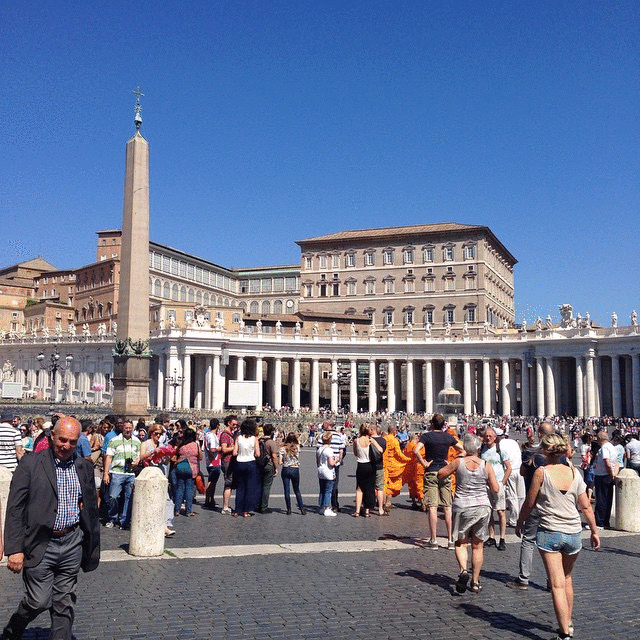
The Apostolic Palace in Vatican City.
Entering the Papal Bubble
July 7, 2015
Pope Francis is leaving for South America on Sunday morning, and I've just gotten back to Rome with enough time to do my laundry and get ready to go with him. I've been in Athens for nearly two weeks, covering the Greek debt crisis, so I'm leaving one huge story for another. It should be great fun.
This is the first time I've been part of the press pool accompanying Francis on one of his international trips. Way back in 2000, I did a little time covering then-presidential candidate George W. Bush, so I've felt the chaos and claustrophobia of being inside the campaign bubble. The papal bubble will be a whole new experience. Francis is one of the most influential figures in the world and he is going to Bolivia, Paraguay and Ecuador. The trip should be fascinating.
I'd love to hear from readers before I leave on Sunday. What do you want to know about the pope? Find me on Twitter at @JimBYardley and let me know.